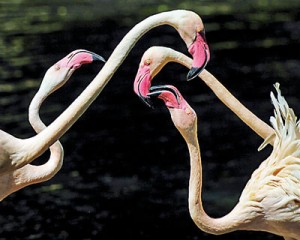Sunday Times 2
Feathered friends: researchers unveil bird ‘family tree’
View(s):WASHINGTON, (Reuters) -Scientists have unveiled the most comprehensive bird ‘family tree’ ever devised, using genetic data from 48 species to trace how modern bird lineages arose and flourished after the mass extinction that killed off the dinosaurs.
The work by researchers from 20 countries helps clarify the evolutionary relationships of modern bird groups and reveals the genetic underpinning of traits such as singing, toothlessness, colorful feathers and color vision.

Flamingos are seen in a nature reserve park in Panyu district south of Guangzhou, Guangdong province, in this November 30, 2014 file photo. Scientists have unveiled the most comprehensive bird "family tree" ever devised, using genetic data from 48 species to trace how modern bird lineages arose and flourished after the calamitous mass extinction that killed off the dinosaurs. REUTERS
The scientists decoded the genomes, an organism’s genetic material, of 45 bird species and analyzed those of three others previously sequenced. The list covered nearly all living bird groups.
The species included penguins, falcons, eagles, woodpeckers, owls, vultures, pelicans, cranes, crows, hornbills, cormorants, hummingbirds, pigeons, ducks, chickens, turkeys, ostriches, finches, loons, flamingos, swifts, and even the White-throated Tinamou.”We have produced a well-resolved bird family tree and provided a clear picture of how the modern birds originated and evolved,” said geneticist Guojie Zhang of the BGI genome research center in Shenzhen, China and the University of Copenhagen.
Scientists think birds evolved from small, feathered dinosaurs. The earliest known bird, Archaeopteryx, lived 150 million years ago.
The researchers said most bird lineages from the age of dinosaurs disappeared during the mass extinction roughly 65 million years ago thought to have resulted from an asteroid striking Earth.
“Birds are dinosaurs. They’re the one lineage of dinosaurs that made it through the mass extinction,” University of Florida biology professor Ed Braun said.
The analysis focused on a group called Neoaves that includes nearly all of today’s 10,000-plus bird species. Its evolutionary explosion spanned 10 to 15 million years following the mass extinction, which opened numerous ecological niches previously occupied by other dinosaurs and flying reptiles called pterosaurs.
The research was published on Thursday in the journal Science and other publications.

